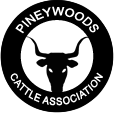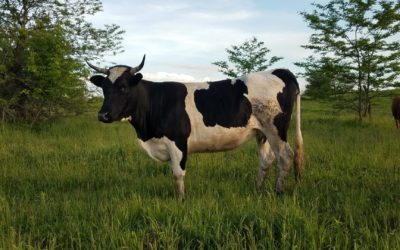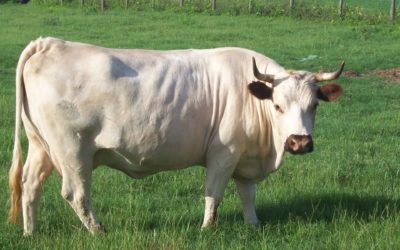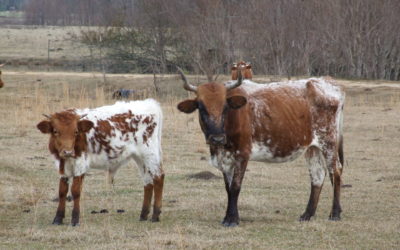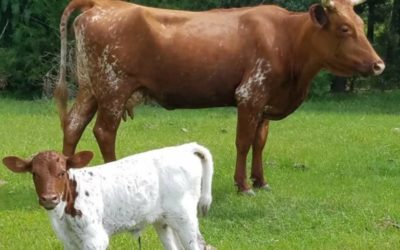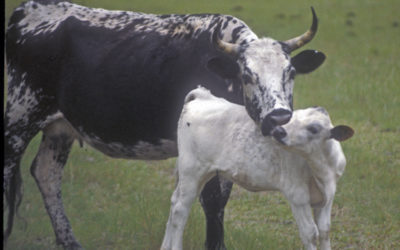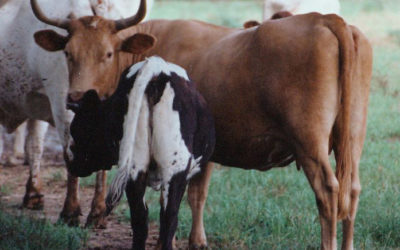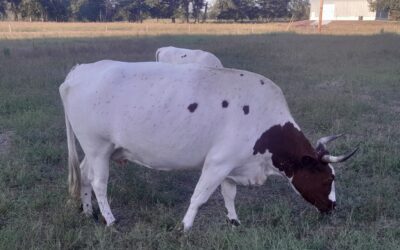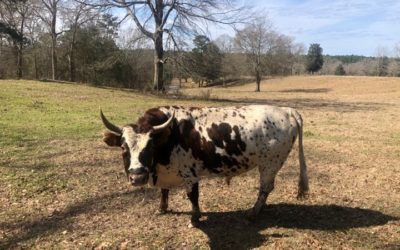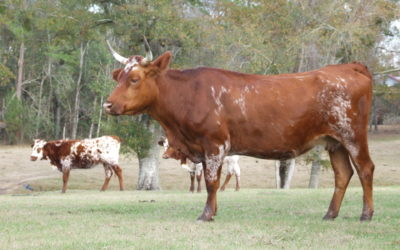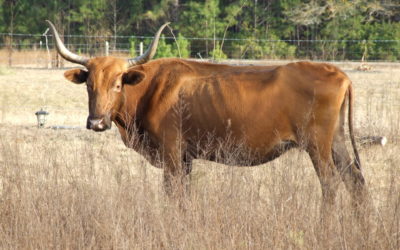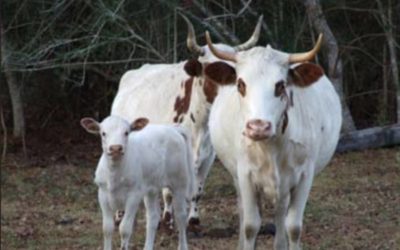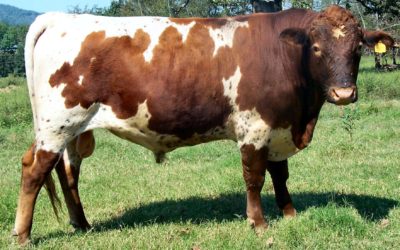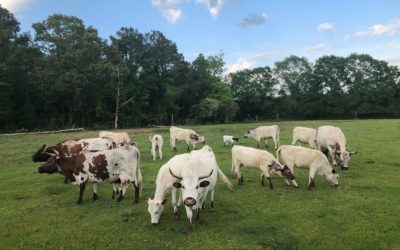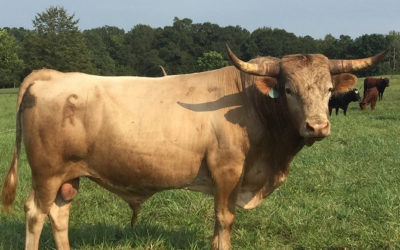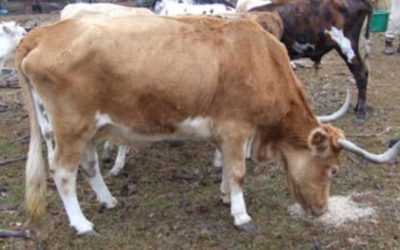Articles
Strains: Independent
Agricola-Knapp
These tend to be medium size Pineywoods, with short to medium length, wide set horns. some having a Spanish twist to the horns. Originally they tended to be fairly uniformly colored, with colored spots or speckling on a white base, or the reverse white on a colored...
Barnes
Barnes cattle vary widely in size, horn shape and color. Most are color sided, color pointed or caped, with black ears and noses. Colors includes blacks, blues, reds,browns and tans. Solid colors happen but are uncommon. The Barnes cattle come from Alabama, and...
Carter, Charlie
These are a medium sized cattle, with medium to long horns turning upward (some with a twist). They are typically color sided or roan with a variety of shades of red and yellow. It is not uncommon for calves to darken with age to include some mild black pigment. Less...
Conway
Conway cattle are all some variety of red and white. Medium sized with a (reportedly) tame disposition. Polled genetics exist but are rare. Conway cattle started with Bura Conway taking over the management of his fathers herd in 1910 at age 14. the last outside...
Hickman
These tend to be on the large and rangy side, with long faces. They also tend to have longer horns, either with a Spanish twist or out and straight up. Colors ranged greatly. Colors and patterns include black, brown, brindle, red, dove, roan, color-sided, caped,...
Holt
Holt are small to medium, and blocky. Horns are short to medium, some crumpled- some twisting out. Colors include red and black, most are color-sided. The Holt line came from Hawkinsville Georgia originally. In about 1917 (after 100 years in Hawkinsville) the herd...
Strains: High Risk
Bayliss
This strain started out as a mix of several older strains. Jack Bayliss married into the Carter family and from there build up his own herd in Petal, Mississippi. In the early days Jack brought in Thornhill and Carter, but his favorite was Griffen. You could see a lot...
Broadus
Broadus cattle tend to be on the small-medium size. The guinea gene shows up in this line more than in others, with some non-guinea cattle still being nearly as small as the guineas. These cattle tend to have a lot of white. They may be color-sided, caped, white faced...
Carter, Luther
Luther Carter was the son of Print Carter, and father of Charlie Carter. Although very similar the cattle Luther kept had some minor differences from the Grandfather and subsequently, the grandson.
Dedeaux
There are very few pure Dedeaux left, mostly in the hands of several descendants in Mississippi. Many of these cows are currently being put with Angus bulls - for the the 'black calf' market. This strain was at extreme risk of extinction ten years ago, and today its...
Diamond
Diamond cattle vary in size, but many are large and rangy. They come in just about every color and pattern. Diamond cattle are reported to be heavy milkers compared to other Pineywoods. The Diamond herd is from Howison, MS. It contains a variety of some of the most...
Ezell
The Ezell cattle were raised in the panhandle of Florida, but the association stock came from Alabama. For this reason Ezell are recognized by the Pineywoods registries AND the Florida Cracker Cattle Association. These are medium sized blocky cattle, with upward...
Ola Ladner
These cattle were also run in the federal woods by Ola Ladner. These are from the same family as Ladnier, but somewhere along the line the 'i' in the name was dropped. Grandson Lionel Ladner owned the last five cows of the original pure Olla Ladner herd in 2010. Only...
Palmer-Dunn
"The Palmer-Dunn strain of Pineywoods is named for Mrs. Muriel Palmer Dunn of State Line, Mississippi. She assembled together a group of old Palmer family cattle and other Woods cattle in her area. The two traits that Mrs. Muriel emphasized the most were docility and...
Robinson
Robinson cattle started as a hodgepodge of cattle collected and assembled into one herd. Today the majority of this line is maintained by Charles Simon of GA.
Yeller Griffen
Griffen cattle were medium-large for Pineywoods. They were yellow with thick proportions and long-broad heads. Their horns were broad with a distinctly Spanish upward and outward twist. They very closely resembled the Spanish cattle of their time. This line of cattle...
Strains: Contributors
Bounds
Bounds cattle dwindled to a cow and a bull owned by the Diamonds. They used an extensive breeding program to capture as much of the Bounds genetics they could. The Diamond herd represents some of the only higher percentage Bounds cattle left today.
Garner
Ladnier
These were originally cattle run in the De Soto National Forest by brothers Leo and Claude Ladnier. In the early 2000's the last two full Ladnier cows died, leaving behind less than a dozen 50% calves. Those calves are all that was left to contribute to what remains...
Seals
Seals cattle were reportedly all some variety of black/blue. Today the small remainder of Seals genetics exists only in the Diamond herd.
Thornhill
Thornhill cattle were of a particular family in Marion, Mississippi. Kept into the 1950's, and numbering upwards of 500, Mr and Mrs. Thornhill referred to these cattle as 'English cattle'. Eventually this strain got down to just one cow. The remainder of the genetics...
Strains: Extinct
Albany
This is a strain that originated in Georgia. We are currently seeking more information on the history of these cattle.
Clark
The last of the Clark cattle were all used in cross breeding programs and the cows eventually died of old age. No pure Clark remain.
Islands
At one point there were Pineywoods type cattle on a variety of islands along the gulf coast. They seem to have remained until about the 70's.
Popple
Popple were from the coastal region of Georgia. They were small red or brindle cattle. The last of the Popple's were only cows and were used in a beef cross breeding herd where they eventually died of old age. These were the remainder of the most eastern variety of...
Purvis
This is a strain that originated in Georgia. We are seeking more information on the history of these cattle
Vice
The Vice strain started out as an old family line, however other strain bulls were consistently brought in. Over time the original Vice line was diminished by a great deal of other strains, most notably Conway since the 1980's. Vice cattle were Horned or Polled,...
